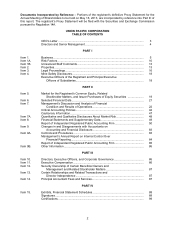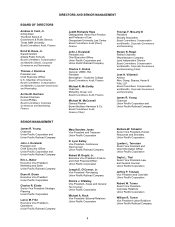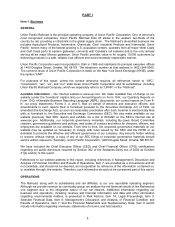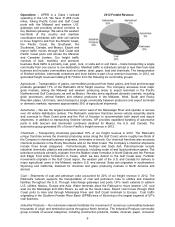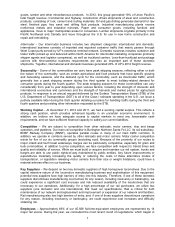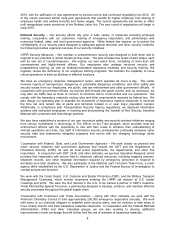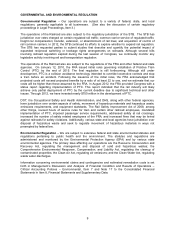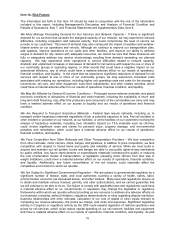Union Pacific 2012 Annual Report Download - page 9
Download and view the complete annual report
Please find page 9 of the 2012 Union Pacific annual report below. You can navigate through the pages in the report by either clicking on the pages listed below, or by using the keyword search tool below to find specific information within the annual report.9
GOVERNMENTAL AND ENVIRONMENTAL REGULATION
Governmental Regulation – Our operations are subject to a variety of federal, state, and local
regulations, generally applicable to all businesses. (See also the discussion of certain regulatory
proceedings in Legal Proceedings, Item 3.)
The operations of the Railroad are also subject to the regulatory jurisdiction of the STB. The STB has
jurisdiction over rates charged on certain regulated rail traffic; common carrier service of regulated traffic;
freight car compensation; transfer, extension, or abandonment of rail lines; and acquisition of control of
rail common carriers. In 2012, the STB continued its efforts to explore whether to expand rail regulation.
The STB has requested parties to submit studies that describe and quantify the potential impact of
expanded reciprocal switching or trackage rights arrangements on railroads. Although several bills
involving railroad regulation expired during the last session of Congress, we continually monitor any
legislative activity involving rail and transportation regulation.
The operations of the Railroad also are subject to the regulations of the FRA and other federal and state
agencies. On January 12, 2010, the FRA issued initial rules governing installation of Positive Train
Control (PTC) by the end of 2015. The final regulation is still forthcoming. Although still under
development, PTC is a collision avoidance technology intended to override locomotive controls and stop
a train before an accident. Following the issuance of the initial rules, the FRA acknowledged that
projected costs will exceed projected benefits by a ratio of at least 22 to one, and we estimate that our
costs will be higher than those assumed by the FRA. In August 2012, the FRA provided Congress with a
status report regarding implementation of PTC. This report indicated that the rail industry will likely
achieve only partial deployment of PTC by the current deadline due to significant technical and other
issues. Through 2012, we have invested nearly $750 million in the development of PTC.
DOT, the Occupational Safety and Health Administration, and DHS, along with other federal agencies,
have jurisdiction over certain aspects of safety, movement of hazardous materials and hazardous waste,
emissions requirements, and equipment standards. The Rail Safety Improvement Act of 2008, among
other things, revised hours of service rules for train and certain other railroad employees, mandated
implementation of PTC, imposed passenger service requirements, addressed safety at rail crossings,
increased the number of safety related employees of the FRA, and increased fines that may be levied
against railroads for safety violations. Additionally, various state and local agencies have jurisdiction over
disposal of hazardous waste and seek to regulate movement of hazardous materials in ways not
preempted by federal law.
Environmental Regulation – We are subject to extensive federal and state environmental statutes and
regulations pertaining to public health and the environment. The statutes and regulations are
administered and monitored by the Environmental Protection Agency (EPA) and by various state
environmental agencies. The primary laws affecting our operations are the Resource Conservation and
Recovery Act, regulating the management and disposal of solid and hazardous wastes; the
Comprehensive Environmental Response, Compensation, and Liability Act, regulating the cleanup of
contaminated properties; the Clean Air Act, regulating air emissions; and the Clean Water Act, regulating
waste water discharges.
Information concerning environmental claims and contingencies and estimated remediation costs is set
forth in Management’s Discussion and Analysis of Financial Condition and Results of Operations –
Critical Accounting Policies – Environmental, Item 7 and Note 17 to the Consolidated Financial
Statements in Item 8, Financial Statements and Supplementary Data.


